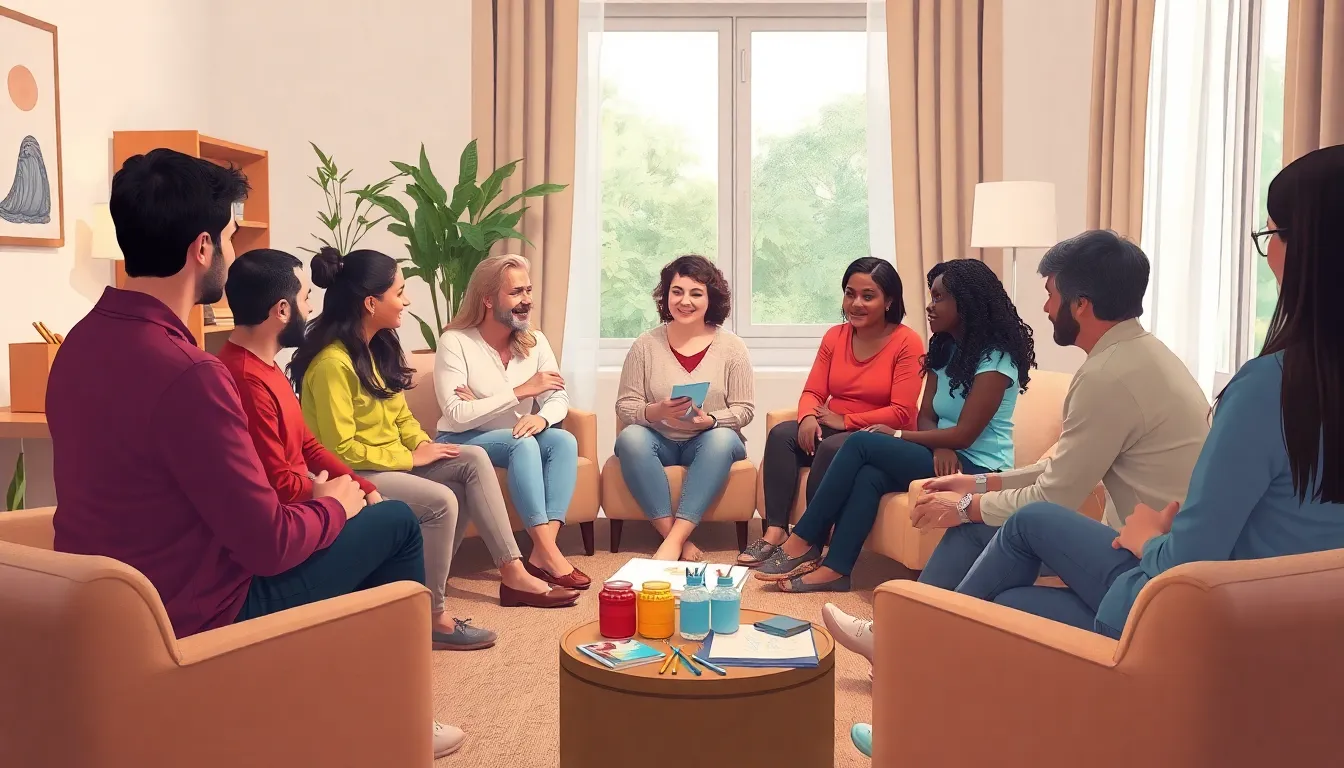Counseling activities might sound like a snooze fest, but they’re anything but! Picture this: a room filled with laughter, creativity, and a sprinkle of heartfelt connection. These activities are designed not only to break the ice but to dive deep into the waters of emotional growth and self-discovery.
Whether it’s through art, games, or engaging discussions, counseling activities transform the therapeutic process into an exciting adventure. They help individuals express themselves, build trust, and tackle life’s challenges with a smile. So, if you thought counseling was just sitting in a chair and talking about feelings, think again! It’s time to discover how these dynamic activities can make a world of difference in the journey toward healing and happiness.
Table of Contents
ToggleOverview of Counseling Activities
Counseling activities encompass a variety of engaging methods aimed at promoting personal growth. They vary from art-based techniques to interactive games, each designed to enhance self-expression. Group discussions create a safe space for individuals to share experiences, fostering emotional connections among participants.
Art therapy, a popular approach, utilizes creative expression to help clients communicate complex feelings. Participants often find a deeper connection to their emotions through drawing, painting, or sculpting. Games, on the other hand, inject fun into the counseling process, making it more appealing while facilitating trust-building. These activities encourage vulnerability in a supportive environment.
Role-playing is another effective method commonly used in counseling. Clients practice real-life scenarios to develop coping strategies and improve communication skills. This hands-on approach empowers individuals to tackle challenges in a non-threatening way.
Mindfulness exercises, such as guided meditation or breathing techniques, also play a critical role. They help participants cultivate awareness of their thoughts and feelings, promoting emotional regulation. By integrating these practices into sessions, counselors guide individuals towards achieving mental clarity.
Integrating various activities creates a dynamic experience, reshaping traditional views of counseling. The environment becomes one where healing and joy coexist, significantly enhancing the overall therapeutic experience. Engaging in these activities ultimately lays the groundwork for lasting change and improved well-being.
Benefits of Counseling Activities


Counseling activities offer numerous benefits that enhance personal growth and emotional well-being. Engaging in these activities fosters deeper connections and encourages individuals to explore their feelings in a supportive environment.
Personal Development
Personal development flourishes through counseling activities. Participants gain self-awareness by actively engaging in discussions and creative expression. Improved communication skills emerge as individuals share experiences and insights with one another. Enhanced problem-solving abilities also develop when participants confront challenges in a safe space. Growth stems from practicing coping strategies in role-playing scenarios, enabling individuals to navigate real-life situations more effectively. Furthermore, art therapy provides avenues for clients to express complex emotions, leading to greater self-acceptance and resilience. Counseling activities empower individuals to take charge of their personal journeys, transforming uncertainty into confidence.
Emotional Support
Emotional support is a crucial benefit of counseling activities. Individuals connect with their peers, helping them feel less isolated in their struggles. Comfort arises from shared experiences, fostering trust among participants. Effective group discussions allow for validation of feelings, ensuring that no one feels alone in their journey. Games and interactive activities create a lighthearted atmosphere that promotes emotional expression. Mindfulness exercises contribute to emotional regulation by equipping individuals with tools to manage stress and anxiety. Engaging in these supportive environments enhances overall mental health, paving the way for lasting emotional fulfillment.
Types of Counseling Activities
Counseling activities encompass various methods that support personal growth and emotional well-being. Several approaches exist to engage clients in meaningful ways.
Group Counseling
Group counseling involves individuals gathering to share experiences and support one another. Facilitated discussions encourage openness and trust, allowing participants to connect on deeper levels. Activities like icebreakers and guided conversations promote bonding among group members. Everyone benefits from the collective wisdom, gaining insights they may not achieve individually. Participants learn effective communication skills while practicing empathy through listening and sharing. This format creates a sense of belonging, reducing feelings of isolation in challenging times.
Individual Counseling
Individual counseling focuses on personalized support tailored to each client’s needs. One-on-one sessions enable deeper exploration of personal issues without the pressure of a group setting. Clients engage in discussions that highlight their unique challenges and aspirations. Direct feedback from the counselor plays a crucial role, guiding clients toward self-discovery. Techniques like goal-setting and journaling enhance the process, allowing for reflection and growth. Clients experience heightened self-awareness and can develop coping strategies specific to their personal situations.
Creative Counseling Approaches
Creative counseling approaches utilize innovative techniques to foster engagement and expression. Art therapy, for instance, encourages individuals to express emotions through various artistic mediums. Music therapy provides another avenue for exploration, using sound to evoke feelings and thoughts. Activities like role-playing allow clients to practice real-life scenarios in a safe space. Mindfulness practices, such as guided imagery and breathing exercises, help clients achieve mental clarity and emotional regulation. These methods promote healing by tapping into the creative aspects of individuals, enriching their therapeutic experience.
Implementing Counseling Activities
Implementing counseling activities involves utilizing specific techniques and creating an appropriate environment that fosters growth and connection.
Techniques and Strategies
Art therapy allows expression through creativity. Interactive games build trust and make sessions enjoyable. Role-playing prepares clients for real-life situations, enhancing problem-solving and communication skills. Mindfulness exercises promote emotional regulation and clarity. Each technique caters to diverse needs, ensuring participants engage through their strengths.
Setting Up a Safe Environment
Creating a safe environment is crucial for effective counseling. Comfort and confidentiality help clients feel secure, allowing open communication. Establishing ground rules fosters trust among participants. A welcoming space with comfortable seating and privacy encourages expression. When clients feel safe, they explore emotions and develop resilience more effectively.
Counseling activities serve as a powerful tool for personal growth and emotional healing. By integrating creative methods and interactive experiences, they transform the counseling journey into an engaging adventure. Clients not only gain valuable skills but also foster connections that enhance their sense of belonging.
The diverse range of activities allows individuals to explore their emotions in a supportive environment. Whether through art therapy or group discussions, these experiences empower clients to navigate life’s challenges with confidence. Embracing this dynamic approach to counseling can lead to lasting change and improved well-being. Ultimately, the effective implementation of these activities paves the way for a brighter future.

